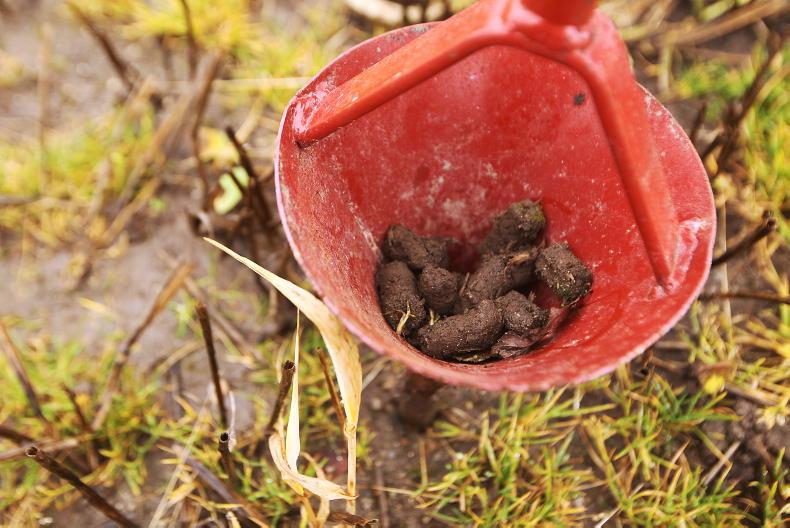Slurry is an increasingly valuable nutrient for farmers, and “far too valuable to be just thrown out”, Louth-based Teagasc adviser Hugh Rooney says.
He wants farmers to think long and hard about when and where to use the slurry that remains in tanks as August comes to a close.
“A thousand gallons of cattle slurry is the equivalent of buying a compound of 9-5-32,” he told listeners of Teagasc’s podcast, The Environment Edge, recently. “So, 20,000 gallons is the same as a tonne of 9-5-32.”
In financial terms, 1,000 gallons of cattle slurry is worth around €30, he adds.
Making the best use of this free fertiliser means using soil analysis to identify the fields lowest in phosphorus (P) and potassium (K), and targeting those areas for slurry application.
Using the farm’s nutrient management plan and “not just having it left in a drawer” is another key action.
“Target the slurry on your lower-fertility fields first,” he says.
While the 9-5-32 composition is the average for cattle slurry, you can carry out a test to confirm the exact composition of slurry from your own farm.
“The gold standard is to get your own slurry tested,” explains Rooney. “But you can also get a rough estimate by using a hydrometer on the farm.”
The water content of the slurry will affect the nutrient levels, so slurry from open tanks or lagoons will be more watery and less nutrient-dense, while slurry from covered tanks with cattle being fed lots of concentrate feed will have a higher nutrient level.
Rooney advises farmers not to wait until just before the closed period begins to empty their tanks.
“Get it out in early September when the days are longer and grass is growing,” he advises.
“A long day’s growth at this time of year could be the same as a week’s growth later on when days are shorter and colder. Get it out sooner rather than later.”
Application rates
On application rates, he advises farmers to go with between 2,000 gallons/acre and 2,500 gallons/acre.
“If you go more than that, it will be lying on the ground, caked and won’t get mopped up by grass growth, potentially waiting for rain that will wash it away and wash away your nutrients,” he says.
From an environmental point of view, spreading at the correct time and in the correct place are key to making best use of slurry.
“Check the forecast and don’t spread when there’s heavy rain forecast in the next 24 to 48 hours. It will just end up in the drain or the nearest stream. “If you’re losing nutrients, you’re losing money. You lose €30 per 1,000 gallons and it’s not good for water quality.”

Use soil testing to identify fields with low fertility and target those first.
Ground conditions must also be suitable, and this is most relevant at the shoulders of the year when the closed period looms.
“There should be no spreading on frosty or waterlogged soils,” he reiterates, adding: “There are umbilical systems that mean you can get slurry spread but if the ground isn’t fit to take a tractor and tanker on it, it’s not fit to take slurry either.”
Adhering to buffer zones alongside watercourses and dry drains is also imperative to prevent leaching of nutrients into water.
“Buffer zones of 5m are required for most of the year, but that doubles to 10m in the two weeks before and after the closed period,” he explains.
These no-spreading buffer zones help to trap pollutants before they reach any watercourse. They slow down the rate of water moving from the field to water and help to filter sediment and nutrients. They are also valuable habitats in their own right.
The website catchments.ie is useful for farmers to identify areas and individual fields on their farm that are particularly vulnerable to different water pressures, whether that is nitrogen- or phosphorus-linked.

Hugh Rooney, Teagasc. \ Barry Cronin
The maps highlight areas of the farm that are susceptible to runoff and areas where farmers can decide to be more careful with slurry application rates and timings.
The long-running Agricultural Catchments Programme has shown time and again that over half of all nutrient losses from agriculture occur during the closed period for slurry spreading.
Weather
“No matter how mild the weather may be, the grass is not growing enough to mop up the nutrients and they get washed into the water. So, get your slurry out in growthy weather,” Rooney urges.
Having adequate slurry storage for the actual slurry production on your farm is also important.
“If a farmer tells me he has to go out with slurry by the end of January, that tells me that while he may have enough storage on paper, in reality they need more,” he says.
“This can be the case when you have soiled water going into slurry tanks and filling them up prematurely. Then you have your back to the wall.
“It’s often March or April before land dries properly and grass is growing, so you need enough storage to get to that point before spreading slurry.
“It’s all about the right time, right place and the right rate.”
Use soil sampling results to identify soil fertility.Target slurry at lowest fertility fields first.Cattle slurry is equivalent to 9-5-32 in an NPK compound fertiliser.Spread slurry in early September when grass is still growing.
Slurry is an increasingly valuable nutrient for farmers, and “far too valuable to be just thrown out”, Louth-based Teagasc adviser Hugh Rooney says.
He wants farmers to think long and hard about when and where to use the slurry that remains in tanks as August comes to a close.
“A thousand gallons of cattle slurry is the equivalent of buying a compound of 9-5-32,” he told listeners of Teagasc’s podcast, The Environment Edge, recently. “So, 20,000 gallons is the same as a tonne of 9-5-32.”
In financial terms, 1,000 gallons of cattle slurry is worth around €30, he adds.
Making the best use of this free fertiliser means using soil analysis to identify the fields lowest in phosphorus (P) and potassium (K), and targeting those areas for slurry application.
Using the farm’s nutrient management plan and “not just having it left in a drawer” is another key action.
“Target the slurry on your lower-fertility fields first,” he says.
While the 9-5-32 composition is the average for cattle slurry, you can carry out a test to confirm the exact composition of slurry from your own farm.
“The gold standard is to get your own slurry tested,” explains Rooney. “But you can also get a rough estimate by using a hydrometer on the farm.”
The water content of the slurry will affect the nutrient levels, so slurry from open tanks or lagoons will be more watery and less nutrient-dense, while slurry from covered tanks with cattle being fed lots of concentrate feed will have a higher nutrient level.
Rooney advises farmers not to wait until just before the closed period begins to empty their tanks.
“Get it out in early September when the days are longer and grass is growing,” he advises.
“A long day’s growth at this time of year could be the same as a week’s growth later on when days are shorter and colder. Get it out sooner rather than later.”
Application rates
On application rates, he advises farmers to go with between 2,000 gallons/acre and 2,500 gallons/acre.
“If you go more than that, it will be lying on the ground, caked and won’t get mopped up by grass growth, potentially waiting for rain that will wash it away and wash away your nutrients,” he says.
From an environmental point of view, spreading at the correct time and in the correct place are key to making best use of slurry.
“Check the forecast and don’t spread when there’s heavy rain forecast in the next 24 to 48 hours. It will just end up in the drain or the nearest stream. “If you’re losing nutrients, you’re losing money. You lose €30 per 1,000 gallons and it’s not good for water quality.”

Use soil testing to identify fields with low fertility and target those first.
Ground conditions must also be suitable, and this is most relevant at the shoulders of the year when the closed period looms.
“There should be no spreading on frosty or waterlogged soils,” he reiterates, adding: “There are umbilical systems that mean you can get slurry spread but if the ground isn’t fit to take a tractor and tanker on it, it’s not fit to take slurry either.”
Adhering to buffer zones alongside watercourses and dry drains is also imperative to prevent leaching of nutrients into water.
“Buffer zones of 5m are required for most of the year, but that doubles to 10m in the two weeks before and after the closed period,” he explains.
These no-spreading buffer zones help to trap pollutants before they reach any watercourse. They slow down the rate of water moving from the field to water and help to filter sediment and nutrients. They are also valuable habitats in their own right.
The website catchments.ie is useful for farmers to identify areas and individual fields on their farm that are particularly vulnerable to different water pressures, whether that is nitrogen- or phosphorus-linked.

Hugh Rooney, Teagasc. \ Barry Cronin
The maps highlight areas of the farm that are susceptible to runoff and areas where farmers can decide to be more careful with slurry application rates and timings.
The long-running Agricultural Catchments Programme has shown time and again that over half of all nutrient losses from agriculture occur during the closed period for slurry spreading.
Weather
“No matter how mild the weather may be, the grass is not growing enough to mop up the nutrients and they get washed into the water. So, get your slurry out in growthy weather,” Rooney urges.
Having adequate slurry storage for the actual slurry production on your farm is also important.
“If a farmer tells me he has to go out with slurry by the end of January, that tells me that while he may have enough storage on paper, in reality they need more,” he says.
“This can be the case when you have soiled water going into slurry tanks and filling them up prematurely. Then you have your back to the wall.
“It’s often March or April before land dries properly and grass is growing, so you need enough storage to get to that point before spreading slurry.
“It’s all about the right time, right place and the right rate.”
Use soil sampling results to identify soil fertility.Target slurry at lowest fertility fields first.Cattle slurry is equivalent to 9-5-32 in an NPK compound fertiliser.Spread slurry in early September when grass is still growing. 







 This is a subscriber-only article
This is a subscriber-only article










SHARING OPTIONS: